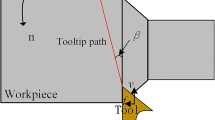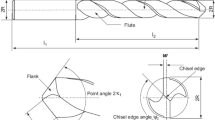Abstract
This paper mainly focuses on the production, consumption, and prediction of cutting energy of a new micro groove turning tool in cutting process and the influence law of cutting parameters in cutting energy, establishes the prediction model of shear energy and friction energy of the new micro groove turning tool, and verifies the reliability of the models above through reasonable cutting experiment. Research results show that the influence of cutting speed, feed rate, and cutting depth on cutting energy especially for shear energy and friction energy is significant and the prediction models of shear energy and friction energy of the new micro groove turning tool have relatively high reliability, which provides a powerful theoretical basis for the prediction of cutting energy under more complex cutting conditions.
Similar content being viewed by others
References
Ma GX, Chang SI, Lei S (2014) Assessment of cutting energy consumption and energy efficiency in machining of 4140 steel. Int J Adv Manuf Technol 74(10):1701–1708
Liu GW, Xia X, Wang QY, Dong RL (2015) Inertia effects of cutting energy absorption. J Traffic Transp Eng 15(3):62–70
kyildiz HKA, Livatyali H (2014) Effect of cutting energy on fatigue behavior of threaded specimens. Int J Adv Manuf Technol 70(3):547–557
Yurdakul M, Akdasc H (2012) Prediction of specific cutting energy for large circular saws during natural stone cutting. Int J Rock Mech Min Sci 53(7):38–44
Yifrach Y, Ben-Hanan U (2013) Cutting zone temperature and specific cutting energy measurement and evaluation in machining metals, 13th International Conference on Fracture. Beijing, China
Wu X, Li L, Zhao M, He N (2016) Experimental investigation of specific cutting energy and surface quality based on negative rake angle in micro turning. Int J Adv Manuf Technol 82(10):9–12
Thakur A, Gangopadhyay S, Mohanty A (2015) Investigation on some machinability aspects of inconle 825 during dry turning. Mater Manuf Process 30(8):1026–1034
Hoyne AC, Nath C, Kapoor SG (2013) Cutting temperature measurement during titanium machining with an atomization-based cutting fluid (ACF) spray system. ASME International Mechanical Engineering Congress and Exposition. Proceedings, San Diego, United States
Sulaiman S, Roshan A, Borazjani S (2013) Effect of cutting parameters on cutting temperature of TiAL6V4 alloy. Appl Mech Mater 392:68–72
Sugita N, Ishii K, Furusho T, Harada K, Mitsuishi M (2015) Cutting temperature measurement by a micro-sensor array integrated on the rake face of a cutting tool. CIRP Annals-Manuf Technol 64(1):77–78
Zou XT, Cong WL, Wu N, Pei ZJ, Wang XW (2012) Novel fiber optic sensors and their application on cutting temperature measurement in rotary ultrasonic machining of titanium. ASME/ISCIE 2012 International Symposium on Flexible Automation 2012: 205-208.
Dosbaeva GK, Ei HMA, Shalaby MA, Krzanowski JE, Veldhuis SC (2015) Cutting temperature effect on PCBN and CVD coated carbide tools in hard turning of D2 tool steel. Int J Refract Met Hard Mater 50(5):1–8
Shu SR, Cheng K, Ding H, Chen SJ (2013) An innovative method to measure the cutting temperature in process by using an internally cooled smart cutting tool. J Manuf Sci Eng 135(6):61018
Shamoto EJ, Kato M, Suzuki N, Hino R (2013) Analysis of three-dimensional cutting process with thin shear plane model. J Manuf Sci Eng 135(4):41001
Li KM, Liang SY (2006) Modeling of cutting temperature in near dry machining. J Manuf Sci Eng 128(2):416–424
Ghai I, Wentz J, Devor RE, Kapoor SG, Samuel J (2010) Droplet behavior on a rotating surface for atomization-based cutting fluid application in micromachining. J Manuf Sci Eng 132(1):11017
Venkatachalam S, Fergani O, Li X, Yang YG, Chang KN, Liang SY (2015) Microstructure effects on cutting forces and flow stress in Ultra-precision machining of polycrystalline brittle materials. J Manuf Sci Eng 137(2):21020
Hoyne AC, Nath C, Kapoor SG (2015) On cutting temperature measurement during titanium machining with an atomization-based cutting fluid spray system. J Manuf Sci Eng 137(2):24502
Sato M, Tamura N, Tanaka H (2011) Temperature variation in the cutting tool in end milling. J Manuf Sci Eng 133(2):21005
Tyurin AN (2011) Dependence of the cutting energy on the parameters in superfinishing. Russ Eng Res 31(7):657–659
Di LA, Tagliaferri V, Veniali F (1993) Specific cutting energy in drilling of composites. Am Soc Mech Eng Mater Div:53–64
Sarwai M, Persson M, Hellbergh H, Haider J (2009) Measurement of specific cutting energy for evaluating the efficiency of bandsawing different workpiece materials. Int J Mach Tool Manuf 49(12):958–965
Wang B, Liu ZQ, Yang QB (2013) Investigations of yield stress, fracture toughness, and energy distribution in high speed orthogonal cutting. Int J Mach Tools Manuf 73:1–8
Author information
Authors and Affiliations
Corresponding author
Electronic supplementary material
ESM 1
(XLSX 42 kb)
Rights and permissions
About this article
Cite this article
Jiang, H., He, L., Yang, X. et al. Prediction and experimental research on cutting energy of a new cemented carbide coating micro groove turning tool. Int J Adv Manuf Technol 89, 2335–2343 (2017). https://doi.org/10.1007/s00170-016-9270-4
Received:
Accepted:
Published:
Issue Date:
DOI: https://doi.org/10.1007/s00170-016-9270-4




